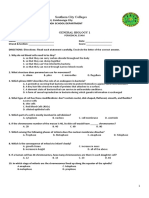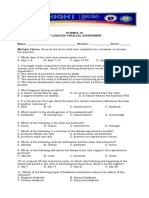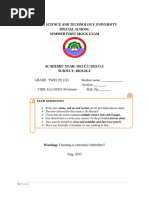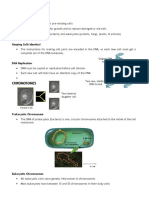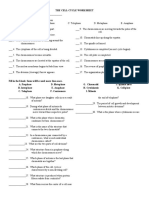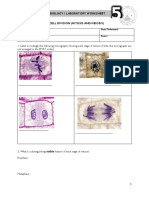0 ratings0% found this document useful (0 votes)
51 viewsScience 8 Reviewer
Science 8 Reviewer
Uploaded by
lucel baganoThis document contains a 45-item science review test on topics related to the human digestive system, cell division (mitosis and meiosis), genetics, and gamete formation. The test contains multiple choice questions to assess understanding of key concepts like the organs of the digestive system, enzymes involved in digestion, stages of mitosis and meiosis, chromosome behavior during cell division, gamete production through spermatogenesis and oogenesis, and genetic conditions. An answer key is provided at the end to check responses.
Copyright:
© All Rights Reserved
Available Formats
Download as DOCX, PDF, TXT or read online from Scribd
Science 8 Reviewer
Science 8 Reviewer
Uploaded by
lucel bagano0 ratings0% found this document useful (0 votes)
51 views14 pagesThis document contains a 45-item science review test on topics related to the human digestive system, cell division (mitosis and meiosis), genetics, and gamete formation. The test contains multiple choice questions to assess understanding of key concepts like the organs of the digestive system, enzymes involved in digestion, stages of mitosis and meiosis, chromosome behavior during cell division, gamete production through spermatogenesis and oogenesis, and genetic conditions. An answer key is provided at the end to check responses.
Copyright
© © All Rights Reserved
Available Formats
DOCX, PDF, TXT or read online from Scribd
Share this document
Did you find this document useful?
Is this content inappropriate?
This document contains a 45-item science review test on topics related to the human digestive system, cell division (mitosis and meiosis), genetics, and gamete formation. The test contains multiple choice questions to assess understanding of key concepts like the organs of the digestive system, enzymes involved in digestion, stages of mitosis and meiosis, chromosome behavior during cell division, gamete production through spermatogenesis and oogenesis, and genetic conditions. An answer key is provided at the end to check responses.
Copyright:
© All Rights Reserved
Available Formats
Download as DOCX, PDF, TXT or read online from Scribd
Download as docx, pdf, or txt
0 ratings0% found this document useful (0 votes)
51 views14 pagesScience 8 Reviewer
Science 8 Reviewer
Uploaded by
lucel baganoThis document contains a 45-item science review test on topics related to the human digestive system, cell division (mitosis and meiosis), genetics, and gamete formation. The test contains multiple choice questions to assess understanding of key concepts like the organs of the digestive system, enzymes involved in digestion, stages of mitosis and meiosis, chromosome behavior during cell division, gamete production through spermatogenesis and oogenesis, and genetic conditions. An answer key is provided at the end to check responses.
Copyright:
© All Rights Reserved
Available Formats
Download as DOCX, PDF, TXT or read online from Scribd
Download as docx, pdf, or txt
You are on page 1of 14
Science 8 Reviewer
Directions: Choose the letter of the correct answer. Write your answers on a
separate sheet of paper.
1. The following organs are part of the human digestive system
EXCEPT:
A. mouth
B. esophagus
C. small Intestine
D. gastrovascular cavity
2. In which part of the digestive system does the breaking down of food into tinier
pieces occur?
A. mouth
B. stomach
C. small intestine
D. large Intestine
3. Which of the following helps in the digestion of food in the mouth?
A. amylase
B. bile
C. protease
D. saliva
4. What enzyme aids the digestion of lipids in the small intestine?
A. amylase
B. gastric enzyme
C. lipase
D. pepsin
5. Which tiny structures line the internal surface of the small intestine to increase
its surface area for the absorption of nutrients?
A. bile ducts
B. cilia
C. salivary glands
D. villi
6. What is the largest internal organ of the human body?
A. heart
B. gall bladder
C. liver
D. stomach
7. Which of the following is produced by the liver?
A. amylase
B. bile
C. pepsin
D. renin
8. Which organ stores bile and pumps it into duodenum?
A. appendix
B. colon
C. gall bladder
D. pancreas
9. What is the result of chemical digestion of carbohydrates?
A. amino acid
B. bile
C. fatty acids
D. simple sugars
10. Where does absorption of nutrients mostly occur?
A. stomach
B. small intestine
C. large intestine
D. all the above
11. What aids the passage of food through the digestive tract?
A. pull from the anus
B. chemical absorption
C. movement of the cilia
D. wavelike muscle contractions
12. What is the main work of the digestive system?
A. fights disease
B. regenerates cells
C. breaks down food.
D. distributes energy throughout the body.
13. Which of the following is the correct order of the digestive tract?
A. mouth → rectum → esophagus → rectum → anus → small intestine
→ large intestine
B. mouth → stomach → esophagus → rectum → anus → small intestine
→large intestine
C. mouth → esophagus → stomach → small intestine → large intestine
→ rectum → anus
D. mouth → esophagus → stomach → small intestine → anus
→ large intestine → rectum
11. Which factor controls hereditary traits?
A. cells C. genes
B. chromosomes D. parents
12. Which phase of the cell cycle does DNA replication occur?
A. G1 phase C. S phase
B. G2 phase D. M phase
13. Which stage in the life of a cell is spent most?
A. cytokinesis phase C. mitotic phase
B. interphase D. synthesis phase
14. Which statement describes what happens during karyokinesis?
A. DNA replication C. doubling of cell size
B. division of nucleus D. synthesizing enzymes for mitosis
15. Humans have diploid chromosome number (2N) which is equal to 46
chromosomes. What is the chromosome number of each daughter cell produced
during meiosis?
A. 1 C. 46
B. 23 D. 92
16. Which factor controls hereditary traits?
A. cells C. genes
B. chromosomes D. parents
17. Which phase of the cell cycle does DNA replication occur?
A. G1 phase C. S phase
B. G2 phase D. M phase
18. Which stage in the life of a cell is spent most?
A. cytokinesis phase C. mitotic phase
B. interphase D. synthesis phase
19. Which statement describes what happens during karyokinesis?
A. DNA replication C. doubling of cell size
B. division of nucleus D. synthesizing enzymes for mitosis
20. Humans have diploid chromosome number (2N) which is equal to 46
chromosomes. What is the chromosome number of each daughter cell produced
during meiosis?
A. 1 C. 46
B. 23 D. 92
For items 21 – 22, refer to the statement below.
Solanum tuberosum or potato has a chromosome number of 24 (2N).
21. How many chromosomes are there during metaphase?
A. 12 C. 36
B. 24 D. 48
22. How many daughter cells are there by the end of telophase?
A. 1 C. 12
B. 2 D. 24
23. Which stage of mitosis where the chromatids of chromosomes separate and
begin
to move away from each other?
A. anaphase C. prophase
B. metaphase D. telophase
24. There are 64 chromosomes of a fern plant. After mitosis, each daughter cell
formed will have how many chromosomes?
A. 2 C. 32
B. 4 D. 64
25. Which diagram correctly represents the process of meiosis?
26. The following statements are true about meiosis EXCEPT:
A. It occurs in reproductive cells.
B. It results in four haploid (N) daughter cells.
C. Exchanging of genetic material does not occur.
D. Pulling apart of homologous pairs of chromosomes occurs.
27. What information is provided to complete column 3 under meiosis?
A. 2 – 2N or diploid C. 4 – 2N or diploid
B. 2 – 2N or haploid D. 4 – N or haploid
28. What process is shown in the illustration of chromosomes below?
29. What is the substage of prophase I where the pairing of chromosomes begins?
A. diplotene C. pachytene
B. leptotene D. zygotene
30. Which stage of your development as a human being when you were just one
cell?
A. baby C. infant
B. fetus D. zygote
31. Which is the correct series of cellular stages in spermatogenesis?
A. spermatids – spermatocytes - spermatozoa
B. spermatids – spermatozoa - spermatocytes
C. spermatocytes – spermatozoa - spermatids
D. spermatocytes – spermatids - spermatozoa
32. Which process does the creation of polar bodies happen?
A. cytokinesis
B. mitosis
C. oogenesis
D. spermatogenesis
33. Which of the following is involved in the maturation of sperms?
A. growth of primary spermatocytes through mitosis
B. formation of ovum from primary oocytes through meiosis
C. creation of polar bodies from primary oocytes through meiosis
D. development of spermatids from primary spermatocytes through meiosis II
34. How many spermatozoa are produced after a primary spermatocyte undergo
spermatogenesis?
A. 2
B. 4
C. 6
D. 8
35. Which statement is TRUE about oogenesis?
A. Polar bodies degenerate.
B. Ovum produced is diploid.
C. Primary oocyte is haploid.
D. Secondary oocyte is diploid.
36. Which statement is FALSE about spermatogenesis?
A. The secondary spermatocytes are haploid.
B. It takes place in the testes of male animals.
C. Each primary spermatocyte becomes four diploid spermatids.
D. Each primary spermatocyte becomes four haploid spermatids.
37. Which is produced by each primary oocyte after oogenesis?
A. four ova
B. one ovum
C. one polar body and three ova
D. three polar bodies and one ovum
38. Which of the following are formed after gametogenesis?
A. body cells
B. gonads
C. sex cells
D. somatic cells
39. What is the role of the polar bodies during oogenesis?
A. It increases the number of sperms.
B. It increases the number of egg cells.
C. It weakens the ovum during fertilization.
D. It removes the excess haploid sets of chromosomes.
40.Which statement is FALSE about acrosome?
A. It is a cap-like structure.
B. It contains digestive enzymes.
C. It develops on the head of the ovum.
D. Its enzymes break the outer sheath of the ovum.
41.The following are the common physical characteristics of people with Klinefelter
syndrome EXCEPT:
A. small testes
B. breast enlargement
C. increased muscle mass
D. presence of few hair on the body and face
42. What is the number of the altered chromosome in Patau syndrome?
A. 5
B. 13
C. 18
D. 21
43.Which is correct about spermatogenesis and oogenesis?
A. spermatogenesis: 1 sperm; oogenesis: 2 eggs
B. spermatogenesis: 2 sperms; oogenesis: 1 egg
C. spermatogenesis: 4 sperms; oogenesis: 1 egg
D. spermatogenesis: 8 sperms; oogenesis: 4 eggs
44.Which one indicates a normal human male?
A. X chromosome
B. XX chromosomes
C. XY chromosomes
D. XXY chromosomes
45.The following are the significance of meiosis EXCEPT:
A. genetic variability
B. sex cell formation
C. asexual reproduction
D. normal chromosomal number upkeep
answer key
1. D
2. A
3. D
4. A
5. D
6. C
7. B
8. C
9. D
10. B
11. D
12. C
13. C
14. B
15. D
16.C
17.C
18. B
19. B
20. B
21. B
22. B
23. A
24. D
25. D
26. C
27. D
28. C
29. D
30. D
31. D
32. C
33. D
34. B
35. A
36. C
37. D
38. C
39. D
40. C
41. c
42. b
43. c
44. c
45. c
You might also like
- Grade 8 Lesson - MitosisDocument3 pagesGrade 8 Lesson - MitosisBerliese Frias93% (30)
- BSC Nursing Previous Year Question PaperDocument16 pagesBSC Nursing Previous Year Question PaperSadiya Pathan100% (1)
- Exercise 1-Activity 1 Physical Basis of Heredity: Name: Date Submitted: Lab Section: Laboratory InstructorDocument8 pagesExercise 1-Activity 1 Physical Basis of Heredity: Name: Date Submitted: Lab Section: Laboratory InstructorJansen Abad100% (1)
- 3rd Quarter g10 With KeyDocument3 pages3rd Quarter g10 With KeyGlaiza Mapute Caringal100% (2)
- Bimm 120 Midterm 1Document28 pagesBimm 120 Midterm 1Melissa LauNo ratings yet
- O Level Biology Practice Questions And Answers: Heredity And Molecular GeneticsFrom EverandO Level Biology Practice Questions And Answers: Heredity And Molecular GeneticsNo ratings yet
- Mitosis - Internet 18-19Document3 pagesMitosis - Internet 18-19Cecilia PeregrineNo ratings yet
- Reviewer in SCIENCE 8Document2 pagesReviewer in SCIENCE 8kuroo's mistressNo ratings yet
- 4QES8Document2 pages4QES8Death SalcamNo ratings yet
- Q4 ST1 G8 30 ItemsDocument5 pagesQ4 ST1 G8 30 ItemsKirito CaroNo ratings yet
- Semi-Finals in Science 8Document2 pagesSemi-Finals in Science 8JosephineNo ratings yet
- 4 6041691479800288107rammmDocument7 pages4 6041691479800288107rammmramadankadir520No ratings yet
- Genbio1 Exam 2 Print To Be SendDocument4 pagesGenbio1 Exam 2 Print To Be SendMohammad Rex MuharramNo ratings yet
- Q4 G8 Summative Test 1 M1 M2 M3Document8 pagesQ4 G8 Summative Test 1 M1 M2 M3Joanabel DechosaNo ratings yet
- Q4 G8 Summative Test 1 M1 M2 M3Document9 pagesQ4 G8 Summative Test 1 M1 M2 M3Joanabel DechosaNo ratings yet
- Summative Test Module 2 ScienceDocument31 pagesSummative Test Module 2 Scienceziontesalona2No ratings yet
- Science 8 - 4th Quarter 22 23Document4 pagesScience 8 - 4th Quarter 22 23Eliseo Ponting JrNo ratings yet
- Exam 1st and 2nd Chapter BioDocument7 pagesExam 1st and 2nd Chapter BioGunay OmarovaNo ratings yet
- Genetics Worksheet For Grade 11Document13 pagesGenetics Worksheet For Grade 11Dagimawi Tewoldebrhan KifleNo ratings yet
- ScienceDocument52 pagesScienceVannyNo ratings yet
- Cell Cycle Test - v1Document5 pagesCell Cycle Test - v1api-316239296No ratings yet
- Multiple Choice Questions: Patterns of Chromosome InheritanceDocument10 pagesMultiple Choice Questions: Patterns of Chromosome InheritanceArwaNo ratings yet
- Biology ShitDocument2 pagesBiology ShitAngie CondezaNo ratings yet
- Science q4 ReviewerDocument14 pagesScience q4 Reviewereong956No ratings yet
- Assessment Grade 8Document5 pagesAssessment Grade 8Emily Saulong Dela CruzNo ratings yet
- MCQ 1Document5 pagesMCQ 1mzhou8910No ratings yet
- Dr. Basel Sherif _ Cytogenetics MCQs.pdfDocument11 pagesDr. Basel Sherif _ Cytogenetics MCQs.pdfkhaled.scribdNo ratings yet
- BIOLOGY, PT1 QuestionsDocument8 pagesBIOLOGY, PT1 QuestionsAbhishek ratnooNo ratings yet
- Bio Mock 1 Answer KeyDocument40 pagesBio Mock 1 Answer KeyMahnoor HassanNo ratings yet
- Wa0036Document15 pagesWa0036Wilson ZhuwakiNo ratings yet
- Final Test For 4th Quarter ScienceDocument1 pageFinal Test For 4th Quarter ScienceLeah DumdumNo ratings yet
- Q3 - SCIENCE 10 Parallel AssessmentDocument4 pagesQ3 - SCIENCE 10 Parallel AssessmentMel VilNo ratings yet
- Republic of The Philippines Department of Education: St. Joseph Village, Cogon, Bogo City, CebuDocument4 pagesRepublic of The Philippines Department of Education: St. Joseph Village, Cogon, Bogo City, CebuSaiza BarrientosNo ratings yet
- Name: Date: Class: Instruction: For Each of The Questions 1 To 30, Choose The Correct Answer For Each Question From The Four Options A, B, C and DDocument4 pagesName: Date: Class: Instruction: For Each of The Questions 1 To 30, Choose The Correct Answer For Each Question From The Four Options A, B, C and Dke2No ratings yet
- Q3 SCIENCE 10 Pretest 2023 2024Document5 pagesQ3 SCIENCE 10 Pretest 2023 2024Rose-AnnMirambilNo ratings yet
- Xii Biology SQP Term I 2021 Kvs CherDocument10 pagesXii Biology SQP Term I 2021 Kvs CherexmemyselfNo ratings yet
- DSTT WordDocument7 pagesDSTT Wordaaronhadri5No ratings yet
- Third Quarter Unit Test in Science 10Document3 pagesThird Quarter Unit Test in Science 10christian dar cabotajeNo ratings yet
- Bio QuestionsDocument69 pagesBio Questionseman.1122505No ratings yet
- chapter_12_-the_cell_cycle_-biology_quiz importantDocument7 pageschapter_12_-the_cell_cycle_-biology_quiz importantareejkhaled383No ratings yet
- Sarajevo School of Science and Technology: Questions 1-22, Circle The Correct AnswerDocument5 pagesSarajevo School of Science and Technology: Questions 1-22, Circle The Correct AnswerAmira SaidNo ratings yet
- q4 40-Item Final ExamDocument2 pagesq4 40-Item Final ExamMary Queen TeroNo ratings yet
- Midterm Exam - DevBioDocument6 pagesMidterm Exam - DevBioeli.ruiz.shslcsinhsNo ratings yet
- PTQ3Document7 pagesPTQ3CINDYNo ratings yet
- Third Quarter Test in Grade 10 ScienceDocument8 pagesThird Quarter Test in Grade 10 ScienceFroilan AlexNo ratings yet
- Unit Test GenbioDocument4 pagesUnit Test GenbioPinky SalesNo ratings yet
- CAT 1 PaperDocument9 pagesCAT 1 Paperkaruranga99100% (1)
- Sayco Bsbio2-5 Midterms PDFDocument22 pagesSayco Bsbio2-5 Midterms PDFeli.ruiz.shslcsinhsNo ratings yet
- Midterm Exam - DevBioDocument6 pagesMidterm Exam - DevBioeli.ruiz.shslcsinhsNo ratings yet
- VILLANUEVA Midterm-Exam DevBioDocument6 pagesVILLANUEVA Midterm-Exam DevBioeli.ruiz.shslcsinhsNo ratings yet
- 1ST Quarter - Exam - Genbio1Document4 pages1ST Quarter - Exam - Genbio1MARIZA MAPALONo ratings yet
- Test-15 ReproductionDocument4 pagesTest-15 Reproductionarehmanmalik619No ratings yet
- 3rd Grading Exam Science 10Document4 pages3rd Grading Exam Science 10Fatima Ybanez Mahilum-LimbagaNo ratings yet
- Pre Test in BOT 101Document14 pagesPre Test in BOT 101arnel AguelNo ratings yet
- Astuss Grade 12 Biology Mock Examination OneDocument13 pagesAstuss Grade 12 Biology Mock Examination Onealexmoges78No ratings yet
- DT-Q1-General Biology 1Document6 pagesDT-Q1-General Biology 1Mary Carmel Gaga-aNo ratings yet
- EMBROYOLGYDocument10 pagesEMBROYOLGYpremiertycoonNo ratings yet
- 4th PT FINALscience8Document5 pages4th PT FINALscience8Berith Grace Magcalas-GallardoNo ratings yet
- WEEKLY TEST 2_20240609_151730_0000Document5 pagesWEEKLY TEST 2_20240609_151730_0000drvaidehi2910No ratings yet
- Ans Chapter 6 Cell DivisionDocument22 pagesAns Chapter 6 Cell Division汪楷熙No ratings yet
- Sample Test in ScienceDocument3 pagesSample Test in ScienceGlaiza Mapute Caringal100% (1)
- Ncert Exemplar Solution of Class 12 Biology Chapter 2Document13 pagesNcert Exemplar Solution of Class 12 Biology Chapter 2Aditya ChauhanNo ratings yet
- Cell CycleDocument2 pagesCell Cyclelhemi100% (1)
- Tugas KktoDocument32 pagesTugas KktoAlaAhdiyaniNo ratings yet
- Answer Key WorksheetDocument1 pageAnswer Key WorksheetDivine Camacho-LanabanNo ratings yet
- Centrioles ReportDocument2 pagesCentrioles Reporttherese lamelaNo ratings yet
- Chapter 10.Document50 pagesChapter 10.eman123elfNo ratings yet
- Meiosis Test Grade 12-2024Document11 pagesMeiosis Test Grade 12-2024lebzah001No ratings yet
- Cell Cycle and MitosisDocument21 pagesCell Cycle and MitosisRazel Casulla100% (1)
- (W3) Cell CycleDocument6 pages(W3) Cell CycleRednaxela Mejico Taruc100% (1)
- Cellular Division Reviewer PDFDocument16 pagesCellular Division Reviewer PDFBrylle Angelo PolintanNo ratings yet
- CDVDDocument16 pagesCDVDmuchi muchoNo ratings yet
- Cueva - Assignment Mitosis and MeiosisDocument11 pagesCueva - Assignment Mitosis and MeiosisCristine Jane CuevaNo ratings yet
- The Cellular Basis of Reproduction and Inheritance: Campbell Biology: Concepts & ConnectionsDocument36 pagesThe Cellular Basis of Reproduction and Inheritance: Campbell Biology: Concepts & ConnectionsAbdelrahman SaberNo ratings yet
- 2 MeiosisDocument36 pages2 MeiosisnthabiisengNo ratings yet
- The Genetic Basis of CancerDocument31 pagesThe Genetic Basis of Cancerapi-418176886No ratings yet
- Cell Cycle and Mitosis WorksheetDocument3 pagesCell Cycle and Mitosis Worksheetjulia.dukeNo ratings yet
- Kvpy 1 Cell Cycle Cell DivisionDocument5 pagesKvpy 1 Cell Cycle Cell DivisionBHARTENDU TIWARINo ratings yet
- Cyto A 24324Document17 pagesCyto A 24324trini purnamasari s.No ratings yet
- Mitosis Vs Meiosis ReadingDocument3 pagesMitosis Vs Meiosis Readingshazia imamNo ratings yet
- The-Cell-Cycle-Worksheet With AnswersDocument3 pagesThe-Cell-Cycle-Worksheet With AnswersHiezel Dapat100% (1)
- PDFDocument4 pagesPDFYordan Gomez Capellan0% (1)
- 2016 Sep RECALLDocument49 pages2016 Sep RECALLkyahuaNo ratings yet
- Mitosis Worksheet PDFDocument3 pagesMitosis Worksheet PDFநித்தியாமதி Nithi KalimuthuNo ratings yet
- 9th Class Biology Test Paper 5Document1 page9th Class Biology Test Paper 5Syed Sibtain RazaNo ratings yet
- Observing MitosisDocument20 pagesObserving MitosisTootsie90% (21)
- IB Biology Notes - 42 MeiosisDocument7 pagesIB Biology Notes - 42 MeiosisJohn Philip D. NapalNo ratings yet
- Mitosis and Meiosis WorksheetsDocument3 pagesMitosis and Meiosis WorksheetsVinson Eric50% (2)
- Cell Division: Mitosis & MeiosisDocument50 pagesCell Division: Mitosis & MeiosisLyca GunayNo ratings yet
- Mitosis Vs Meiosis Quiz - KEYDocument2 pagesMitosis Vs Meiosis Quiz - KEYJanecil A. BonzaNo ratings yet












